From Douglas Britt:
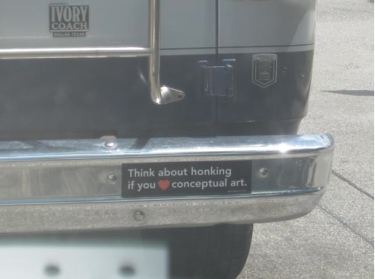 Two from Marfa:
Two from Marfa:

Regina Hackett takes her Art to Go
So then, because you are lukewarm, and neither cold nor hot, I will vomit you out of My mouth. (Revelation 3:14-22)
Titus Kaphar vomits history. He tars, feathers and tears it up. He peels it off, like sunburned skin. He allows it to leak through surface paint slathering, first eyes, then mouth: the white behind the black and the black behind the white, the racial stew of our collective story.
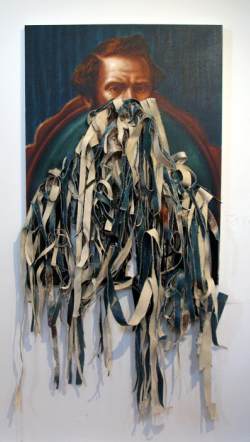 Seen in reproduction, his paintings can pass for tricks. First he makes copies of the past, then he destroys them. In person, however, the intensity of his paint handling shines through its violations.
Seen in reproduction, his paintings can pass for tricks. First he makes copies of the past, then he destroys them. In person, however, the intensity of his paint handling shines through its violations.
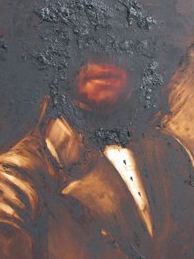 If the past awoke and walked down the street, we’d bar the door, but portraits that survive to represent various times and places tend to be lovely.
If the past awoke and walked down the street, we’d bar the door, but portraits that survive to represent various times and places tend to be lovely.
We study the lace at her throat, the sword at his hip, the polished furniture behind them.
Kaphar honors this house by burning it down. He upends it. We see it, finally, painfully, through the lens of the present, what we know about the old and the new, not just figureheads standing in the boat but the muscle at the oar.
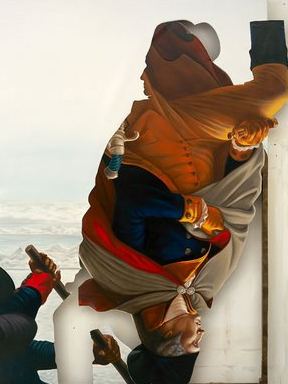
In The New Yorker via email from Douglas Britt, in honor of The Puppet Show at the Frye:
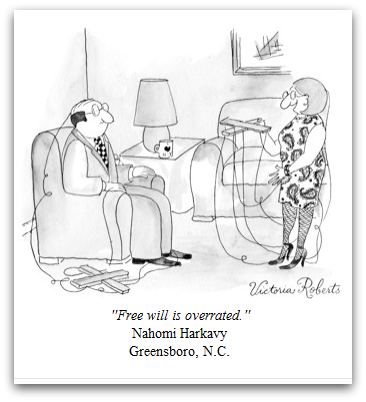
Formerly with the real PI, the two-woman force field in food writing, Rebekah Denn and Leslie Kelly, each have their own thriving blogs and related writing projects. That leaves the online PI with a citizen journalist restaurant critic, who in this context works for free.
In mainstream food criticism, if you to eat with a restaurant critic, you’ll get a lecture ahead of time on what not to say and what you’re responsible for ordering.
Critics want to sample the menu without being obvious. The main thing you can’t say? That you’re eating with a restaurant critic. The whole premise of a review falls apart if the restaurant knows a critic is on the premises. The critic will be favored (duh), which means the meals s/he writes about are not the meals served to just anybody. That’s why critics wear big hat and sunglasses in photos, when photos exist at all. They pay cash or use credit cards in somebody else’s name.
This just in from the citizen journalist who now functions as the PI’s restaurant critic. Click restaurants/dining under A&E, and you’ll get him.
Two of my co-workers have basically moved into Volunteer Park Cafe (link added). They work out of the cafe many days out of the week. This adorable little cafe located in an otherwise residential portion of the Capitol Hill neighborhood in Seattle is quite homey, so it’s no surprise they’re making it their workday “home”. In addition, as I joined them and another friend for lunch, after we ordered, one of the “regulars” informed the owner that I’d be writing about my meal.
In addition to all the food we ordered and paid for, a plate of free cookies and cake magically appeared towards the end of our meal. I make it a rule not to let restaurant owners know why I’m there and I pay for my food. I chastised the informer appropriately, but I did eat those cookies.
My general philosophy is that I try to be as fair as possible. I don’t ask for special treatment, and I don’t expect any. That said, I do photograph my food and restaurant folk are not dopes.
His friends didn’t get the shalt-not rap when it mattered, ahead of time, and he photographs his food. Yes indeed. Restaurant folks are not dopes.
Real restaurant critics have their own eccentricities. When he was at the PI, Tom Sietsema, now at the Washington Post, used to follow a few small, well-considered bites of any item by dousing the remainder with salt and pepper. It’s how he ate out almost every night and kept his lovely figure. I believe restaurants in Seattle were on the look-out when waiters cleared plates for those encrusted with condiments. If it was the salad, they could come back big with the entrees and desserts.
When an exhibit is traveling, local venues frequently complement what arrives in crates with what can be carried across town. A Picasso and Matisse, together again, blockbuster? We can add to that. European Impressionism, peak and post? We can match that.
The exception is contemporary. If an exhibit on a contemporary theme is on the road, rare is the regional museum able/willing to integrate the home grown with the imported.
Why? If done badly, it’s better not done. Good examples of Picasso exist lots of places. But faith that artists in a particular region can succeed in a global context is harder to come by.
The Puppet Show from the ICA is a hit at the Frye. That’s great, but why not spread that applause around?
Take Seattle’s Mr. Puppet, Warner Blake, veteran of innumerable street fairs and puppet dinner theaters. No room for his orchestra on the back of a turtle, his suitcase-sized marching band?
It would have been easy to make a little.
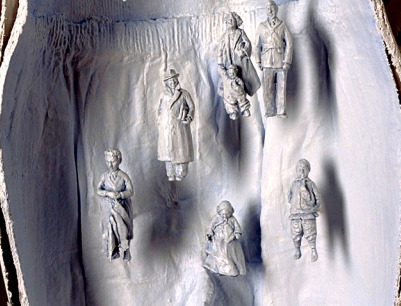
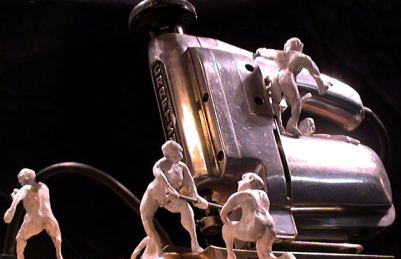
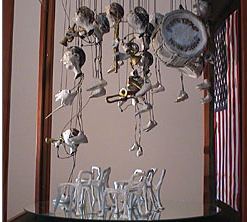
Check it out. In my case, he means he tough-loves me. Dave Horsey to me:
Regina, I still love you, even though your comments about me are preposterous.
This post – Dave Horsey derides his former (fired) PI colleagues – remains big in journalism circles, although most of the discussion is not on this blog. But good responses continue to trickle in, from the irritated (Emily White, whom I think might have intended to respond to this post, which referred to her PI tenure) to the amused (Casey Corr).
White was at the PI for (roughly) a hard half-a-year. Corr was on the staff when I showed up in the early 1980s, put in close to a decade and moved on. Point is, Corr and I (and Horsey) go way back.
Corr:
To readers of (Another) Bouncing Ball: I’m going to slip this comment in weeks
after the original posting in the hopes that only readers but not
Regina Hackett see itFirst, I sat next to Regina Hackett
back at the old P-I on Wall Street (where the Globe spun for a reason)
and not once did she say she found me brilliant. So that sets me apart
from Emily White. Regina never even called me semi-smart.Second, Dave
Horsey’s tactic of telling a critic that he loves her is the first
thing he learned on the (University of Washington’s) Daily, back when he and other Dolly
Parton-style big hairs were chasing Charles Odegaard trying to slip out
the back door of the Administration Building at the University of
Washington.In fact, Horsey yelled “I love you” to Odegaard in a
shameless effort to get an exclusive. It worked. Odegaard stopped and
thus Horsey gained his first Pulitzer.As for Horsey saying he loves
Regina Hackett, I can only say, get in line, pal. I loved sitting near
Hackett so much that when I turned coat and went to the Seattle Times,
I graciously allowed Regina to have my old phone number, 448-8332.
(That number now rings into a dictation machine that transcribes
comments into a blog called 8332.)Later, I tried to get Dave to join
me at the Times but he had an understandable concern about the chilly
water that flowed in the veins of the editorial-page editor of that
era. Finally, if ArtsJournal decides to throw a fancy party for its
advertisers, I’m quite willing to give the speech and celebrate the
shock of the new, or the new new thing, or the value of hits or eye
balls, or whatever puts digital journalism on the cutting edge of
cutting costs as the mass medium turns mini, along with the pay checks.Have tux, will travel. Casey Corr
P.S. If by chance, this posting is a
duplicate, I apologize. I got an error message when I tried to post the
first version and lost my draft. The blogging world has its cruelties.
Enjoying a conversation with a hospital security guard who once slammed a man face first into a glass wall for spitting on her, I missed the fact that I’d followed the line out onto Lead Pencil‘s ramp rising on a steep diagonal at Seattle’s Moore Theatre.
I’m afraid of heights. Titled Exit Ramp, the piece cut the theater in half and gave those traveling on it a new view of the space below. What that new view was I can’t say. As my knees locked, I focused on a woman in a wedding dress with gray ashes on her white-washed face who was leaning out from the balcony above and singing Mozart.
The song and the sight of her (old-worldly with a hung-in-the-closet, suppressed glamour), distracted me from an interview that came to mind at this most inopportune moment. In it, Brendan Kiley asked Lead Pencil’s Annie Han about her fears for Exit Ramp.
.
The eternal fear of structural collapse and bodily injury on any
project bigger than a man is tall.
Exit Ramp is part the Free Sheep Foundation‘s Moore Inside Out, a Saturday-night only project with 50 Seattle artists and performers that treated the whole theater as a gallery, including stairs and corridors, basement and backstage.
Thousands showed up. As Kiley wrote in his preview,
Free Sheep roots out forgotten places, their histories and memories,
and distills them into potent, one-shot events that leave indelible
burns on the city’s collective memory. Free Sheep happenings are
mayflies on fire.
Lines curved around the block to get in. Once inside, there was more waiting. Few appeared to have any idea of what they were waiting for. People joined a line and shuffled along in a collective mood of happy-to-be-surprised.
Not everybody, of course. I ran into an art historian who said, “Typical Seattle mediocrities.” She was waiting for her yoga teacher to perform and looked as if she were holding her breath.
The crowd was the thing. Seattle is frequently a place where an audience is hard to come by, which means this audience – everybody there for performance art – was heartening to itself.
Something important got lost in the self-congratulations, however.
[Read more…] about Free Sheep Foundation – Moore Inside Out (Fear of heights)
The new ornate: Kehinde Wiley
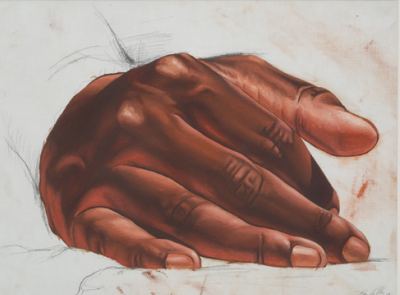 The old rough and tumble: Ed Templeton (with stigmata)
The old rough and tumble: Ed Templeton (with stigmata)
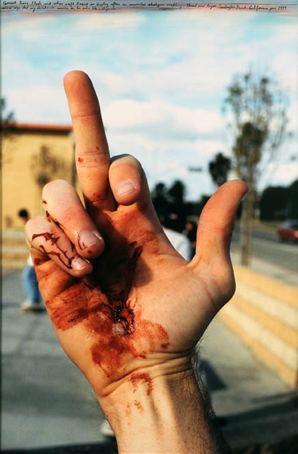 Their merger: Debra Baxter – Brass Knuckles/Tongue (Hurts So Good)
Their merger: Debra Baxter – Brass Knuckles/Tongue (Hurts So Good)
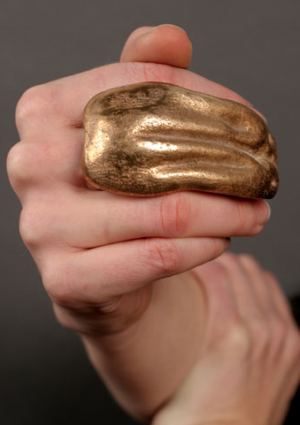
an ArtsJournal blog


